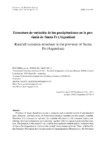Mostrar o rexistro simple do ítem
Estructura de variación de las precipitaciones en la provincia de Santa Fe (Argentina)
| dc.contributor.author | Zucarelli, Agostina | |
| dc.contributor.author | París, Marta | |
| dc.contributor.author | Macor, José | |
| dc.date.accessioned | 2020-01-22T12:40:48Z | |
| dc.date.available | 2020-01-22T12:40:48Z | |
| dc.date.issued | 2019 | |
| dc.identifier.citation | Cadernos do Laboratorio Xeolóxico de Laxe: Revista de xeoloxía galega e do hercínico peninsular, ISSN 0213-4497, Nº 41, 2019, páxs. 59-74 | es_ES |
| dc.identifier.issn | 0213-4497 | |
| dc.identifier.uri | http://hdl.handle.net/2183/24744 | |
| dc.description.abstract | [Resumen] Las prácticas de muchas disciplinas requieren un registro completo y consistente de datos de precipitación. Sin embargo, habitualmente no se dispone de series históricas de las variables hidrometeorológicas. Por lo tanto, es necesario optimizar la información disponible mediante estimaciones, considerando que estos cálculos sean consistentes con el fenómeno regional analizado. El propósito de esta investigación fue definir regiones pluviométricas homogéneas en la provincia de Santa Fe (Argentina) que sirvan de base para optimizar la red de mediciones existente. Para ello se utilizaron los datos publicados por la Dirección Provincial de Comunicaciones de la Provincia. Ante la imposibilidad de lograr una matriz de precipitaciones medias mensuales que contenga datos de lluvia que cubran la totalidad del territorio provincial, se definieron regiones con valores mensuales de precipitación correspondientes a los años 2006 y 2007, mediante el análisis de agrupamiento jerárquico por el método Ward. Como parte de la caracterización inicial se realizó el control de consistencia de la información, se analizó la estructura geoestadística de variación espacial de las precipitaciones mensuales y se trazaron las curvas isohietas. Ello permitió corroborar y caracterizar las variaciones espaciotemporales de la variable. Se identificaron tres regiones pluviométricas homogéneas, cada una de las cuales tiene una delimitación espacial definida con precipitaciones anuales medias características que oscilan en los 1100 mm para el NE provincial, 1350 mm para el centro sur y 1500 mm para el centro de la provincia. El sector NO no pudo ser caracterizado por falta de datos. En lo que respecta al análisis de calidad del resto de la base de datos los resultados no son alentadores pues presentan deficiencias sustanciales que condicionan la confiabilidad de las series registradas | es_ES |
| dc.description.abstract | [Abstract] Practices of many disciplines require a complete and consistent record of precipitation data. However, historical series of hydrometeorological variables are not usually available. Therefore, it is necessary to optimize the available information with estimated values, considering that these estimations are consistent together with the regional analyzed phenomenon. The purpose of this research was to define homogeneous rainfall regions in the province of Santa Fe (Argentina) to improve the rainfall measurement network. Data published by the Dirección Provincial de Comunicaciones (Communications Directorate of the Province) were used. Due to the impossibility of achieving a matrix of average monthly rainfall that contains rainfall data covering the entire provincial territory, regions with monthly rainfall values corresponding to the years 2006 and 2007. The hierarchical cluster analysis by the Ward method was used. As part of the initial characterization, the control of information consistency was performed, the geostatistical structure of spatial variation of the monthly precipitations was analyzed and the rain curves were plotted. This allowed corroborating and characterizing the spatiotemporal variations of the variable. Three homogeneous rainfall regions were identified, each of which has a defined spatial delimitation with average annual rainfall characteristics ranging from 1100 mm for the provincial NE, 1350 mm for the south center and 1500 mm for the center of the province. The NW sector could not be characterized by lack of data. About the quality analysis of the rest of the database, the results are not encouraging because they present substantial deficiencies that condition the reliability of the series recorded. | es_ES |
| dc.language.iso | spa | es_ES |
| dc.publisher | Universidade da Coruña, Servizo de Publicacións | es_ES |
| dc.relation.uri | https://doi.org/10.17979/cadlaxe.2019.41.1.5814 | es_ES |
| dc.subject | Regiones homogéneas | es_ES |
| dc.subject | Análisis de agrupamiento | es_ES |
| dc.subject | Geoestadística | es_ES |
| dc.subject | Redes pluviométricas | es_ES |
| dc.subject | Homogeneous regions | es_ES |
| dc.subject | Cluster analysis | es_ES |
| dc.subject | Geostatistics | es_ES |
| dc.subject | Rainfall networks | es_ES |
| dc.title | Estructura de variación de las precipitaciones en la provincia de Santa Fe (Argentina) | es_ES |
| dc.title.alternative | Rainfall variation structure in the province of Santa Fe (Argentina) | es_ES |
| dc.type | info:eu-repo/semantics/article | es_ES |
| dc.rights.access | info:eu-repo/semantics/openAccess | es_ES |
| UDC.journalTitle | Cuadernos de Estudios Gallegos | es_ES |
| UDC.volume | 41 | es_ES |
| UDC.startPage | 59 | es_ES |
| UDC.endPage | 74 | es_ES |






